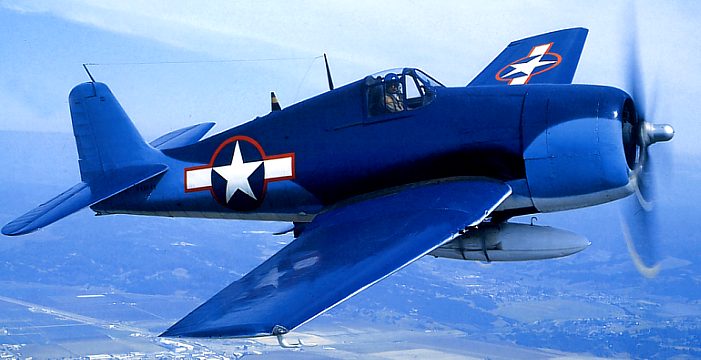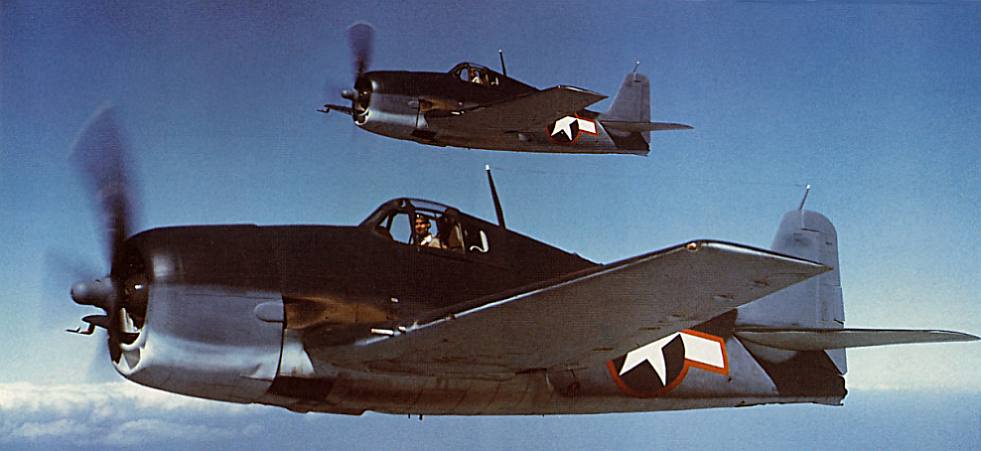
The
Hellcat was the main shipboard fighter of the US Navy for the last two
years of the Pacific War. During the Gilbert and Marshall Operations, the
raid on Truk, in the Battle of the Philippine Sea and at Leyte Gulf, the
entire fighter complement of the Fast Carrier Force consisted of F6Fs - at
Philippine Sea Task Force 58 fielded some 450 fighters, all of them being
F6F-3s, and at Leyte Gulf, as Task Force 38, the Carrier Force was
equipped with nearly 550 fighters, all of them Hellcats. This illustrates
the astounding degree of standardisation achieved in the American
frontline forces, something made possible only by the vast output of US
industry (this standardisation in its turn aiding efficiency in production).


The F6F was ordered for the US Navy after the initial shock of Allied
contact with superior Japanese fighters, particularly the Mitsubishi A6M
Zero, during the first few months of the Pacific War. As a result of this
experience of combat against higher-performance machines the Hellcat's
specification required the most powerful engine available. The prototype
X6F-1, a progression from the F4F Wildcat which was then the standard
fighter of the Navy, was provided with a 1700hp Wright R-2600 engine, but
a month later - on 26 June1942 - it was re-engined with a 2000hp Pratt and
Whitney R-2800 (the birth of the F6F therefore coinciding almost exactly
with the great carrier Battle of Midway, 4-6 June 1942, in which its
predecessor - the Grumman F4F Wildcat - played a critical role).

Production F6F-3s made their first combat flights on 31 August and 1
September1943, from the carriers Yorktown (CV10), Essex (CV9)
and the light carrier Independence. The Hellcat immediately
outclassed its opponents, having higher speed and rate-of-climb, being
rugged and well-armoured but at the same time very maneuverable for such a
large machine, and carrying a heavy and effective armament of six
0.5-inch Browning machine-guns with a large ammunition supply. The arrival
of the F6Fs in late 1943, combined with the deployment of the new Essex
and Independence Class carriers, immediately gave the US Pacific
Fleet air supremacy wherever the Fast Carrier Force operated.
A
total of 2,545 Hellcats were delivered in 1943, in 1944 no fewer than
6,139, and in 1945 a further 3,578 - total production was 12,272 units.

The Hellcat was eventually credited with destroying more than 6,000
Japanese aircraft - 4,947 of these by F6Fs of the USN carrier squadrons
(209 of the others by land-based Marine Corps F6Fs, and the remainder by
Hellcats of other Allied countries). The F6F's most spectacular exploit
was the destruction of more than 160 enemy aircraft in one day - 19 June
1944 - in the Battle of the Philippine Sea, in the aerial massacre
usually known as "The Great Marianas Turkey Shoot."

The F6F was also used extensively as a search aircraft and fighter-bomber,
playing a major and increasing part in strikes on Japanese warships and
mercantile shipping in 1944 and 1945. In this role, and for ground attack,
it could carry up to 2,000 lb. of bombs, or be armed with six 5-inch
rockets on underwing pylons.

Foto by Gordon Bain - reproduced by
courtesy



